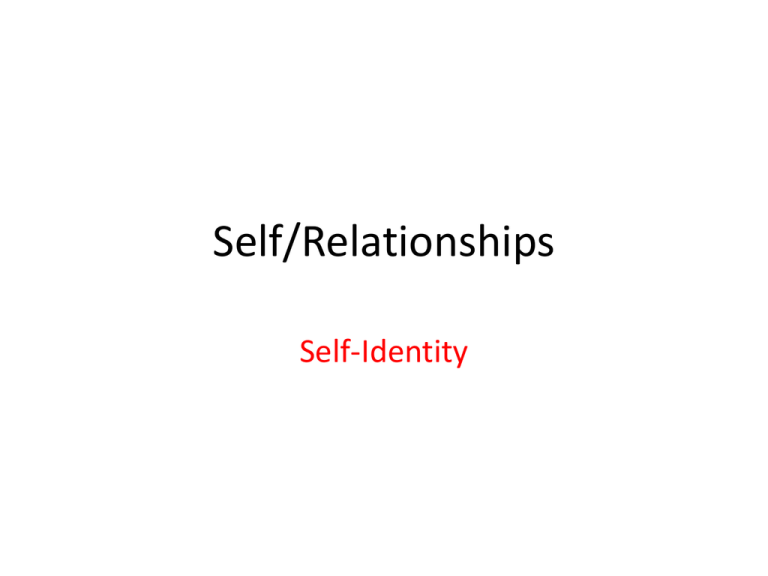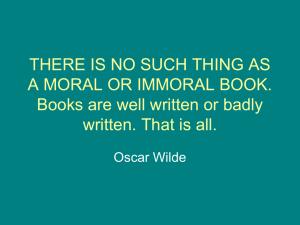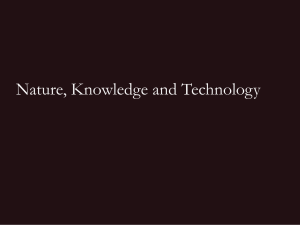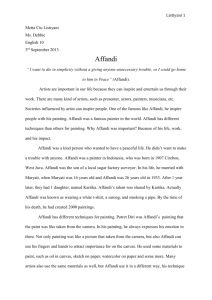Van gogh, Affandi & Bayu
advertisement

Self/Relationships Self-Identity - A three-quarter view of the artist with a bandage on his right ear. He is wearing a green cloak and a fur cap. Behind him is a painting of geishas in kimonos and mt. fuji. Towards the right of the work, we see a suggestion of a door with details of paneling. To the left, we see a candlestick-like structure. Vincent van Gogh Self-Portrait with Bandaged Ear. 1889 Oil on canvas - In Van Gogh’s painting, short and straight/ vertical strokes were used throughout. The overlapping vertical lines made him look stiff and the lines also suggest a sense of anxiety/tension. - Dominant shades of green give the painting a cold/chilly atmosphere, which could suggest the loneliness experienced by the artist. Close-up portrayal of the face helps to direct our attention to the artist’s emotions Vincent van Gogh Self-Portrait with Bandaged Ear. 1889 Oil on canvas - Van Gogh appears distraught; probably suffering from the earlier accident/fight with Paul Gauguin. A solemn/sorrowful atmosphere envelops the room. There is no eye contact between Van Gogh with the audience and this further emphasized his sense of loneliness & depression. - The overlapping strokes used also appear like a fence that separates him from the viewer. He is alone in his suffering and we are unable to reach out to him. Vincent van Gogh Self-Portrait with Bandaged Ear. 1889 Oil on canvas Here, Van Gogh is dressed in a rather smart jacket & waistcoat, appearing serious & somewhat calm. He seems to be glancing out at us in an uncertain manner. The orange beard contrasts with the overall blue colour scheme. (Blue & orange are complementary colours). The light blue background is enlivened with stylized swirling brushstrokes. Such free and overlapping strokes are echoed in the clothes of Van Gogh, his hair and moustache. Vincent Van Gogh Self-Portrait 1889 Oil on canvas Affandi (1907 - 1990) - Indonesian Expressionist artist Affandi Nostalgia of Mother 1940 Oil on canvas - Portrait of his mum showed adequate mastery of anatomy & academic skills - Contours of the face, with eyes, nose & mouth received close attention & accentuation - Hands: Showed impression of linear movement, painted with less patience Revealed signs of expressive tendencies Affandi A Child & its Blind Father Mixed Media - Sketch of an old, blind man being led by a small boy - Both are dressed in rags Affandi: - Admired Van Gogh’s expressive style & humanitarian life view Van Gogh. Bedroom in Arles. 1889 Affandi My Room 1942 Oil on canvas - A number of figures study a map - Oil paint has been quickly & sketchily applied with loose strokes & lines Affandi The Militia Prepare their Strategy 1946 Oil on canvas Affandi (1907 - 1990) - Focus on visual & emotional expression in his work - Themes Poverty , injustice, struggle for independence - Characteristic Style: - Thick, impasto technique, showing strong movement & expressive tension - Squeezed paint directly on canvas & used hands/tube’s nozzle to paint Affandi: Self Portraits Self portrait = Representation of the self, & the self’s existential experiences Affandi I am Under the Lamp 1964 Oil on canvas Affandi Self-Portrait 1975 Oil on canvas Read jumbled responses - Depicts himself as an elderly man with unkempt and thinning head of hair and thick features - Captures his physical likeness & conveys a sense of life & personality - He looks out from the picture to face the viewer Self-Portrait 1975 - Style: - Gestural application of paint & Fauvist colour sense - Suggests himself as a robust man whose forceful presence is asserted formally through wildly coloured palette - Physical energy propelled through spirited brushstrokes on the picture surface Self-Portrait 1975 Caring 1971 Self Portrait with Pipe 1977 - Self portrait with accompanying motif of a sun -- an alter-ego - Dynamic, swirling strokes. Wajahku 1981 - Self portrait embracing solar eclipse - Sorrowfully embracing black ball of eclipsed sun, the disappearance of which meant the death of everything and meanings in universe - Capture essence of life force which suffuses universe Solar Eclipse 1983 - Identify with and repeatedly attempt to capture the sun in paint, thick and dynamic swirls in blue, or orange, or red, black - Touch of melancholy -convinced that he would die in 1987. - A whisk of bamboo and a red sun + sketchy image of himself against background of canvas - Self image in light oil-colours, almost disappearing into background, fading away Unsuccessful 1987 - Effects lie more in relief of thick impasto than in any outline or colour. Dead Chicken 1987 - Form of a dead fighting cock hangs upside down in the centre of the canvas - Bottom right, face of Affandi emerges from the shadows, a ghost like apparition, severed from any bodily context - Dismembered head on the ground, where the feet of the living tread = identifcation with dead cock and death (imminent death?) - Use of darker greys mixed with whites and yellow Affandi: Self Portraits - Created individualized, expressionist paintings as means to perceive reality - Saw himself as the medium to explore one’s emotional and psychological depth - Influence of Van Gogh: Image of the suffering artist & Sense of empathy for human suffering - As a Life-giver -- Use of image of sun / eclipse • Affandi: PAINTING = A process of fixing into colour and form the storm of energy from emotions which had arisen through concentrating on something that inspired it - Tends to leave his works unfinished - Expressionistic: - More true to the subjects than any photo-realistic works - Engaged, honest emotional experiences deemed more important than intellectual analysis Bayu Utomo Radjikin (Born 1969) (Malaysian artist) Bayu Utomo Radjikin (Born 1969) (Malaysian artist) Untitled 4 Bayu Utomo Radjikin 2011 228cm x 165cm Charcoal and acrylic on canvas Bayu Utomo Radjikin Lang Kacang 1991 Mixed media Size: 141 x 104 x 120cm. Bayu Utomo Radjikin Lang Kacang 1991 Mixed media Size: 141 x 104 x 120cm. Bayu Utomo Radjikin Lang Kacang 1991 Mixed media Size: 141 x 104 x 120cm. Bayu Utomo: ~ Fascination for warriors - A sentimentality for Malay symbols - Theme: - War & misery - Self-righteousness, confidence, pride, heroism, perseverance - Sculpture depicting a warrior without arms, probably belonging to a tribal group in Sarawak, Malaysia. He seems to be standing in an upright & sturdy position, with his legs wide open, ready to attack or defend. (just like a proud soldier) With his head tilted up, he seems confident enough to win any battle. The body is gone but armour is still in place (suggest bravery); Armless but still ready for battle (suggest strength) His mouth is wide open, suggesting that he is probably shouting just as how warriors would in a battle. Bayu Utomo Radjikin (Malaysia) Lang Kacang 1991 Mixed media Size: 141 x 104 x 120cm. - Sense of mystery/myth: face resembles that of an animal; half human, half animal? Reminds one of tribal sculpture through the use of feathers & materials. The dark grey armour coupled with the brown of the face & legs further suggest tribal roots - The metal & other scrap materials used made reference back to the traditional warrior armour and war accessories (tattoo?) Bayu Utomo Radjikin Bujang The Brave 1991 Metal & mixed media 97cm x 55cm x 100cm National Art Gallery Permanent Collection Sculpture Bayu Utomo Radjikin x figure 1993 oil on canvas 83cm x 110cm - We see the expression of utter terror on the child's countenance, the vulnerability of its emaciated frames pressed against a wall and helplessness of the clasped hands and the eyes, wide opened witnesses to all that is horror and abjection. - The expression on the child is obvious to all; there can be no doubt about it and it forms a striking contrast to the convoluted background. - The backdrop: somewhat like the ink-blot tests; it elicits and defeats attempts at conclusive explanation. Bayu Utomo Radjikin x figure 1993 oil on canvas 83cm x 110cm - There you see substances of the artist's vision on the labyrinthine complexities of the world, anxiety laden absurdities of life and the powerfully oppressive forces at hand. The nightmare within this canvas is now resonating with the chilling reality. - Evokes the modern man's angst and grotesque alienation in an unintelligible and hostile world. Bayu Utomo Radjikin (Malaysian artist) - Works with the themes of war and suffering in his artworks - Explore the issues that these human conditions brought about. Some artists use their art to depict various socio-political, socio-economic and socio-ecological conditions. Issues such as war, social unrest, urbanisation and the destruction of nature have always been of concern to artists. Their artworks serve as visual records of these events, and as expressions of their opinions about the society they live DISCOVERING IDENTITIES Since the 1990s, a multiracial group of Malaysian artists has placed greater emphasis on sociological issues arising from the multiracial and multicultural realities of modern Malaysia. Adopting a broader approach to artistic creativity, these artists have highlighted issues related to the self and the other, notions of minority identity, and questions related to the environmental transformations that are taking place as the nation embarks on an accelerated industrialization process. Among the issues raised by these artists are matters related to multi-ethnic cultural values and aspirations in the face of a national cultural policy. Also projected are issues of cultural dislocation faced by immigrant societies as they sink their roots into their country of adoption. Influences derived from the rapidly expanding information age contexts and their effects on the heterogenous malaysian social matrix are also featured. Other works by Bayu Utomo The world through the eye of a Malaysian artist "Conversation by the square; Trafalgar ” 57.5cm x 139.5cm, Oil on Canvas, 2005 "Conversation by the river; Thames” 57.5cm x 139.5cm, Oil on Canvas, 2005 Conversation at Picadilly Circus” 57.5cm x 139.5cm, Oil on Canvas, 2005 "Monologue at Tate Britain” 57.5cm x 139.5cm, Oil on Canvas, 2005 Bayu Utomo Words at the Acropolis, Athens 2006 Acrylic on canvas, 58cm x 139cm Bayu Utomo Words at the Brandenberger Tor, Berlin, 2006 Acrylic on canvas 58cm x139cm Bayu Utomo Sight 2006 Acrylic on canvas, 40cm x 100cm References http://www.age.jp/~pranoto/bookenglish/003.htm http://antropologifoto.blogspot.sg/2011/10/affandi-legend-of-indonesian.html http://bayuutomo.blogspot.sg/ http://www.theedgemalaysia.com/lifestyle/171027-cover-story-bayu-thewarrior.html








